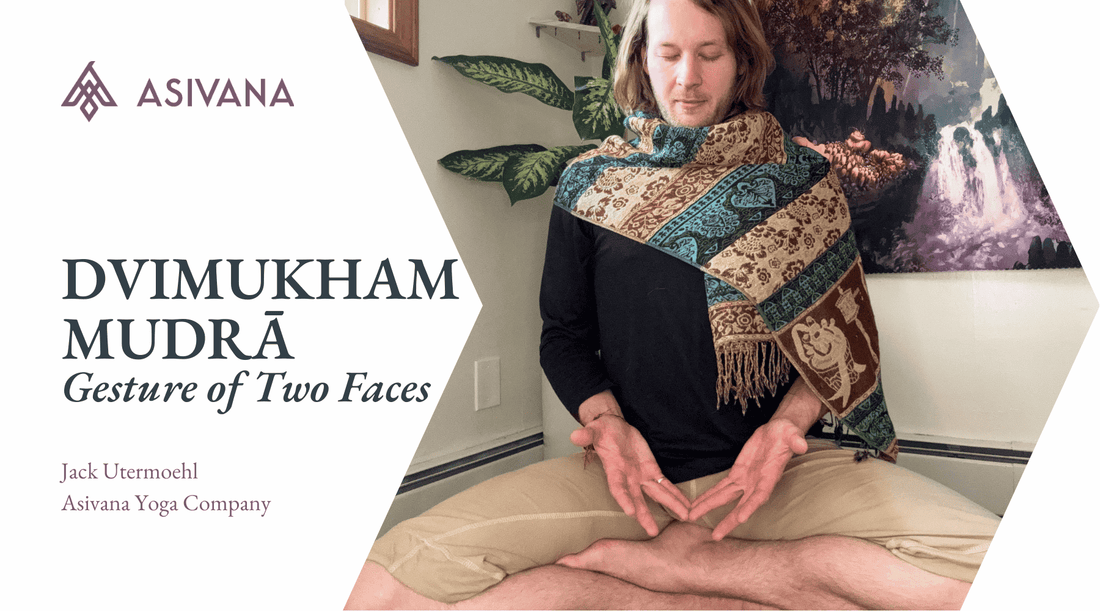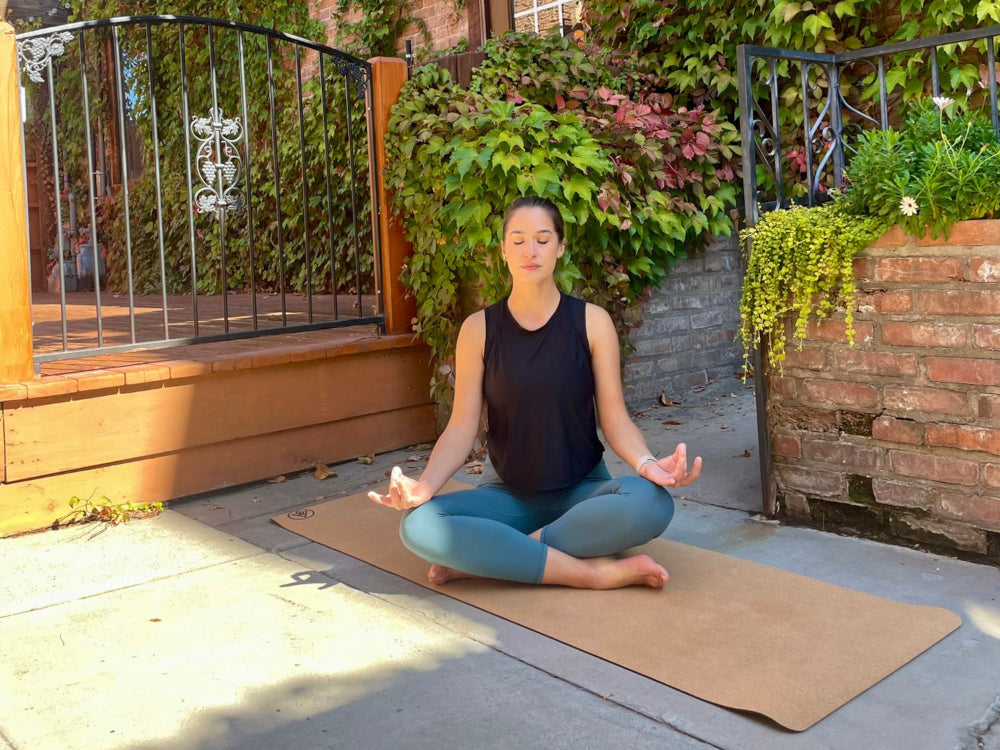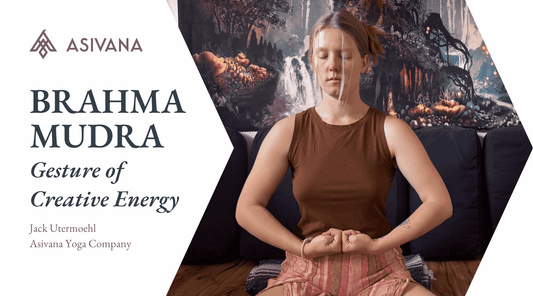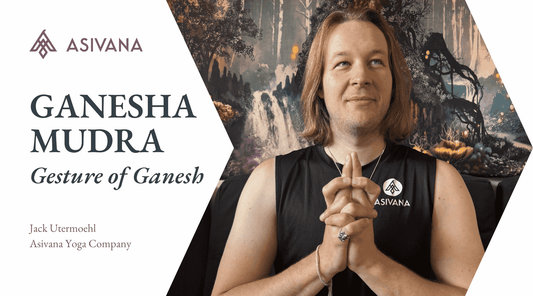
Dvimukham Mudra - Gesture of Two Faces
Jack UtermoehlShare
Dvimukham Mudra (Gesture of Two Faces)
Sanskrit Name: Dvimukham Mudrā - द्विमुखं मुद्रा
English Translation: Gesture of Two Faces
Phonetic Spelling: Dvee-MOO-kham Moo-Drah
Dvimukham mudra, or the gesture of two faces, represents the balance between duality—our limited self and our limitless self. This mudra encourages the practitioner to connect with their expansive, boundless nature, inviting deep relaxation and mental tranquility.
'Dvi' is a Sanskrit number meaning “two” and 'mukha' is “face”. In the west the phrase “two-faced” has a negative connotation however in respect to dvimukham mudra, we’re assessing the duality of reality.
The two faces symbolize the dual aspects of our being, helping to alleviate stress, promote emotional balance, and invoke a state of calm.

Instructions to Perform Dvimukham Mudra
Find a comfortable seated position with your spine upright, or lie down to promote relaxation. Take several slow breaths to center yourself.
Hand Position: Bring the tips of your little and ring fingers together, with each hand mirroring the other. Keep your palms facing upward, resting just below the navel. Your forearms should gently hug your abdomen.
Posture: Sit in sukhasana (easy pose) or padmasana (lotus pose).
Breathing Technique: Inhale deeply and slowly through your nose, allowing your belly to rise with each breath. Exhale gently, releasing any tension in the body. Focus on the duality of your being—the limited self and the expansive, limitless self.
Duration: Hold dvimukham mudra for 5-10 minutes, focusing on deep relaxation and emotional balance.
Benefits of Dvimukham Mudra
Dvimukham mudra evokes deep relaxation and emotional harmony. It is particularly beneficial for calming the nervous system and reducing stress.
Physical Benefits: Helps reduce stress and tension, promoting relaxation and lowering blood pressure.
Mental Benefits: Creates mental calm and clarity, helping to alleviate anxiety and insomnia.
Emotional Benefits: Encourages emotional balance and tranquility by connecting the practitioner to their limitless nature.
Spiritual Benefits: Invites a deeper understanding of duality and connection to the expansive, limitless self.
Capture your insights and deepen your connection with our Yoga Journal.Elevate Your Mudra Practice
Symbolism and Meaning of Dvimukham Mudra
Dvimukham, meaning two faces, symbolizes the balance between our limited, individual self and the expansive, universal self. This mudra encourages the practitioner to release identification with the limited personality and connect to their boundless, limitless self. Through this connection, stress and tension are dissolved, and a state of peacefulness is achieved.
The hands, held together at the fingertips, create a symbolic unity between the dual aspects of our being. This helps to evoke a sense of wholeness and balance in the mind and body.
When to Practice Dvimukham Mudra
Dvimukham mudra is particularly useful in the evening or before bedtime to promote restful sleep and deep relaxation. It can be practiced during stressful moments or to reduce anxiety and tension.
Use this mudra when seeking emotional balance, calm, or preparing for sleep. It is an ideal mudra to integrate into a relaxation or yoga nidra practice.
A duration of 5-10 minutes is recommended for relaxation.
Contraindications for Dvimukham Mudra
Dvimukham mudra is gentle and suitable for all practitioners. If you experience discomfort in your hands, adjust the hand position or shorten the duration.
Additional Insights on Dvimukham Mudra
Affirmations: "I connect with my limitless self, free from stress and tension." / "I am calm, centered, and at peace."
Visualization: As you hold dvimukham mudra, visualize two sides of your being—the limited self and the expansive self—merging together. Imagine a wave of calm spreading through your body, dissolving tension and bringing deep peace.
Associated Chakras: This mudra activates the Anahata (heart chakra).
Paired Asanas: Works well with calming postures like savasana (corpse pose) or sukhasana (easy pose).
Related Pranayama: Pair dvimukham mudra with slow belly breathing or deep, diaphragmatic breathing to enhance relaxation and emotional balance.
Meditation Techniques: Dvimukham mudra is ideal for meditation focused on relaxation, stress relief, and balancing emotional energy.
Variations and Modifications
Alternative Hand Positions: Bhairava Mudra, Dharmadhatu Mudra
Adaptations for Beginners: Beginners can start by holding dvimukham mudra for shorter periods, such as 2 minutes, and gradually increase the duration as they become more comfortable. Resting the elbows on a cushion can provide additional support during longer sessions.
—— 🕉 ——

Personal Insights
Practicing Dvimukham mudra has become an essential part of my evening practice for achieving deep relaxation and drifting off to sleep. This mudra has been particularly effective in alleviating stress and anxiety from the activities of my day.
The ‘two faces’ of Dvimukham mudra are our limited personality and our limitless true being. The issue we experience is a misidentification with the subject of sovereign consciousness. When we can experience or identify as the limitless self, we enter a state of peacefulness.
If you have a yoga Nidra practice, this mudra may amplify your experience, or put you to sleep. While your mileage may vary, it’s worth performing at least once in my experience.
I am called to remember often that right now, right here, there is nothing wrong or out of place. It is a perfect, eternal moment. Dvimukham mudra helps me enter that mind state.
Have you tried Dvimukham mudra for sleep or relaxation? Let us know below.











